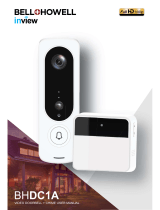
This device complies with Part 15 of the FCC Rules /
Industry Canada licence-exempt RSS standard(s).
Operation is subject to the following two conditions:
(1) this device may not cause harmful interference,
and (2) this device must accept any interference
received, including interference that may cause
undesired operation.
Changes or modifications not expressly approved
by the party responsible for compliance could void
the user's authority to operate the equipment.
This equipment has been tested and found to
comply with the limits for a Class B digital device,
pursuant to part 15 of the FCC Rules.
Le présentappareilestconforme aux CNR d'Industrie Canada
applicables aux appareils radio exempts de licence.
L'exploitationestautorisée aux deux conditions suivantes :
(1) l'appareil ne doit pas produire de brouillage, et
(2) l'utilisateur de l'appareildoit accepter tout brouillagera-
dioélectriquesubi, mêmesi le brouillageest susceptible
d'encompromettre le fonctionnement.
Caution
Troubleshooting
Avoid placing the doorbell or bell push on metallic surfaces.
Move the doorbell to a new location.
The doorbell only works at short distance:
Ensure the doorbell is switch on.
Follow the “clear memory” guide to reset to doorbell, then
follow the “pairing” steps to setup the doorbell.
Doorbell will not ring when push button is pressed:
Note
Range Guide
Metallic surface may reduce transmitter power.
METAL
0-20%
BRICK
60-80%
WOOD
80-90%
OPEN AIR
90-100%
Reorient or relocate the receiving antenna.
Increase the separation between the equipment and
receiver.
Connect the equipment into an outlet on a circuit different
from that to which the receiver is connected.
Consult the dealer or an experienced radio/TV technician for
help.
Caution
These limits are designed to provide reasonable
protection against harmful interference in a
residential installation.
This equipment generates use and can radiate
radio frequency energy and, if not installed and
used in accordance with the instructions, may
cause harmful interference to radio communica-
tions. However, there is no guarantee that
interference will not occur in a particular installation.
If this equipment does cause harmful interference to
radio or television reception, which can be
determined by turning the equipment off and on,
the user is encouraged to try to correct the
interference by one or more of the following
measures:
Power Supply:110-125 VAC;
Working Range:≥100m in open area
Transmitter:
IP protection class:IP44
Techincal Data






